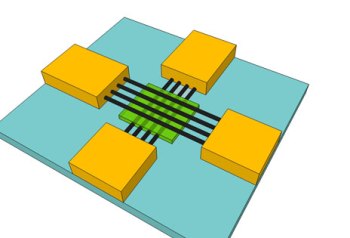A group of Stanford University scientists have developed nanoscale variants of two advanced memory technologies from carbon nanotubes.
 A vertical version of memory, in which phase-change material is sandwiched between bottom and top electrodes
A vertical version of memory, in which phase-change material is sandwiched between bottom and top electrodes
Generally, silicon memory chips won’t work at nanoscale sizes. The results prove that memory even when reduced to 10 nanometers in size or below can deliver the same performance as flash memory.
Professor at Stanford, H.S. Philip Wong and his coworkers created mini-versions of two types of memory called resistive random-access memory (RRAM) and phase-change memory (PCM), which could replace flash.
The two memories exhibit non-volatile characteristics which means they have the capacity to retain stored data even in the absence of power supply and are designed to be easier to miniaturize and faster. They can also read and write minute sets of bits when compared to flash, thus saving energy.
To develop the memory structures, the team cultivated nanotubes on quartz and used a coating of gold with a thickness of 100-nm, which when peeled off, pulls the nanotubes along with it. Then the gold-nanotube layer is then made to adhere to a silicon substrate. Following this, chemicals were used to etch the gold away and leave behind the nanotubes on the surface.
Wong’s team developed a 6- by 6-nm RRAM cell with two crosshatched nanotube layers with a layer of aluminum oxide in between them. Data in the memory is varied by applying a voltage that is high enough to form a conductive path via the resistive aluminum oxide. The team could develop a fully functional memory cell that gets activated with current of less than 10ìA and voltage of about 10V.
The team constructed a PCM from a combination of antimony, germanium, and tellurium, which also proved effective. The researchers discovered that they could switch a 2.5 nm² cell from its crystalline, conductive state to its amorphous, resistive state using a current of just 1.4 µA.
Wong’s team used the same level of current as used by Eric Pop and his team at the University of Illinois at Urbana-Champaign who tested the first carbon-nanotube-based PCM. Pop’s team developed nanotube memory by arranging phase-change material in a space along a horizontal design carbon nanotube.
Wong and his coworkers developed a vertical design of this memory, in which phase-change material was placed between the top and bottom electrodes. Wong says that the vertical design is more compact than horizontal designs and will enable PCM cells to be reduced in size like flash memory.